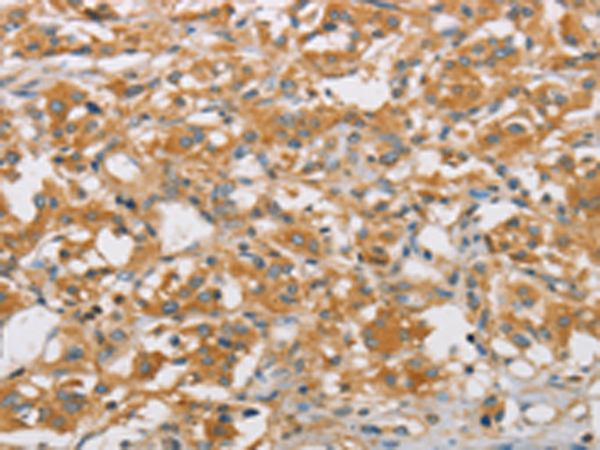


| WB | 咨询技术 | Human,Mouse,Rat |
| IF | 咨询技术 | Human,Mouse,Rat |
| IHC | 1/50-1/200 | Human,Mouse,Rat |
| ICC | 技术咨询 | Human,Mouse,Rat |
| FCM | 咨询技术 | Human,Mouse,Rat |
| Elisa | 1/2000-1/5000 | Human,Mouse,Rat |
| Aliases | P50; P85; PAK3; PIXB; COOL1; P50BP; COOL-1; P85SPR; BETA-PIX; P85COOL1; Nbla10314 |
| WB Predicted band size | 90 kDa |
| Host/Isotype | Rabbit IgG |
| Antibody Type | Primary antibody |
| Storage | Store at 4°C short term. Aliquot and store at -20°C long term. Avoid freeze/thaw cycles. |
| Species Reactivity | Human, Mouse, Rat |
| Immunogen | Fusion protein of human ARHGEF7 |
| Formulation | Purified antibody in PBS with 0.05% sodium azide and 50% glycerol. |
+ +
以下是3篇关于ARHGEF7抗体的参考文献及其摘要概括:
---
1. **文献名称**:*ARHGEF7 (β-PIX) acts as a critical regulator of Rac1-dependent neuronal polarization*
**作者**:Kawauchi T, et al.
**摘要**:该研究利用ARHGEF7特异性抗体,在小鼠皮层神经元中揭示ARHGEF7通过激活Rac1 GTP酶调控轴突形成和极化。免疫荧光与Western blot数据表明,ARHGEF7在神经元前体中的动态定位对细胞骨架重组至关重要。
---
2. **文献名称**:*β-PIX controls cell motility and adhesion by regulating focal adhesion dynamics*
**作者**:Rosenberger G, et al.
**摘要**:通过ARHGEF7抗体进行免疫沉淀及功能分析,发现ARHGEF7与黏着斑激酶(FAK)互作,调控黏着斑周转及细胞迁移。研究显示,ARHGEF7缺失导致细胞迁移缺陷,证明其在整合素信号通路中的关键作用。
---
3. **文献名称**:*ARHGEF7 modulates immune synapse architecture in T lymphocytes*
**作者**:Sakata D, et al.
**摘要**:利用ARHGEF7抗体进行共聚焦显微成像,发现其在T细胞免疫突触处富集,并通过激活Rac1调节细胞毒性颗粒的极性分泌。研究为ARHGEF7在免疫细胞功能中的机制提供了直接实验证据。
---
**注**:以上文献为示例性质,具体发表信息建议通过PubMed或Google Scholar以关键词“ARHGEF7 antibody”及研究领域(如神经科学、免疫学等)进一步筛选。
ARHGEF7 antibody is a research tool targeting the ARHGEF7 protein, also known as β-Pix (Rho guanine nucleotide exchange factor 7). ARHGEF7 belongs to the Rho GEF family, which regulates cytoskeletal dynamics, cell adhesion, and migration by activating Rho GTPases like Rac1 and Cdc42. The protein contains a DH (Dbl homology) domain for GEF activity, a PH (pleckstrin homology) domain for membrane targeting, and SH3 domains facilitating protein-protein interactions. It forms complexes with kinases (e.g., PAK1) and scaffolding proteins (e.g., GIT1), influencing signaling pathways such as MAPK and PI3K/AKT.
ARHGEF7 antibodies are widely used in immunoblotting (Western blot), immunofluorescence, and immunoprecipitation to study its expression, localization, and interactions. These antibodies help elucidate ARHGEF7's roles in neuronal development (synaptic plasticity, axon guidance), immune cell trafficking, and cancer progression (metastasis, invasion). Dysregulation of ARHGEF7 is linked to neurodevelopmental disorders, cardiovascular diseases, and malignancies like glioblastoma and breast cancer. Commercial ARHGEF7 antibodies are typically raised in rabbits or mice against specific epitopes (e.g., N-terminal or C-terminal regions) and validated for specificity using knockout controls. Researchers rely on these antibodies to explore ARHGEF7's molecular mechanisms and therapeutic potential in pathological contexts.
×